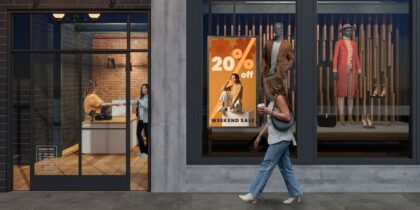The bank of the future prototype has undergone many paradigm shifts in terms of design, services and components. However, indoor digital signage remains a core element that can bridge the brick-and-mortar physical world with the virtual digital world. Vibrant indoor digital signage draws over 400 percent more views than static displays and compels engagement, notes Embed Signage.
On average, U.S. retail bank customers visit their local branch offices twice a month, with an average lobby wait time of 7:06 before being assisted. This presents a recurring window of opportunity to address a de facto captive audience with dynamic indoor digital signage to market products, shape the brand, educate and entertain while reducing perceived wait times.
The Online Migration of Retail Bank Customers
The by-product of the migration to online and mobile banking is the dramatic drop in branch foot traffic resulting in rising branch closures. Retail bank customers now complete basic banking transactions online, while reserving branch visits for more complex issues. Bank of America, JPMorgan and Citigroup have closed 389 branch offices combined since Q3 2015, according to Business Insider.
However, branch closures are actually a testament to the efficiency of mobility; the cost savings enhance the bottom line. Paul Donofrio, CFO of Bank of America, states that 18 percent of deposit transactions are now completed through mobile devices at “one-tenth the cost of walking into a branch.” Wells Fargo plans to close 400 branch offices by 2018, which will produce $2 billion in cost-savings annually.
How Retail Banks Can Thrive in Today's Digital Age
Explore short- and long-term opportunities to transform brick-and-mortar branch experiences. Download Now
Necessity Spurs the Evolution of the Bank of the Future
Surviving bank branches are adapting to the shifting dynamic by forging ahead with the bank of the future, not as an option but as a necessity to remain competitive. The models range from frictionless, fully automated self-serve branches to high-touch, relationship-centric community hubs armed with teams of human specialists aimed at maximizing every single customer engagement. Balancing the digital and physical, the frictionless and high-touch, and the automated and human-assisted are all factors to be considered.
However, a digital signage strategy is also a necessity to both prototypes to usher in a soft landing. While built-from-scratch, high-tech modern bank branches are planned, the majority of existing branches will have to undergo a measured transformation without disrupting the existing daily flow of operations.
Refining the Digital Branch Image
Indoor digital signage can be one of the first augmented components to be outfitted in the upgrade/transformation cycle. The visual impact of digital signage instantly draws attention from customers by connecting with them on a cognitive level with vibrant images that reinforce the brand.
Digital signage imbues a live dynamic and adaptive ambiance that enhances the stature of the conventional branch office. It projects the air of modernization, assuring customers that the bank is indeed on the forefront of digital innovation. Perception is reality, and banks that ignore the relevance of projecting a more digital “appearance” can be perceived as complacent and potentially lose customer loyalty.
In fact, the benefits of the transformation towards the “digital” brand has produced tangible results. According to The Financial Brand, a recent study published by J.D. Power reported that customer satisfaction scores for the six largest U.S. retail banks have surpassed small and medium-sized banks for the first time ever in 2016, largely due to the digital offerings, improved customer interactions and the growing millennial base.
Flexibility Meets Functionality
Naturally, a carefully crafted content strategy needs to be employed to optimize the efficiency of the digital signage. Each campaign can be a clean slate or a continued progression of resonating themes. Perhaps the true beauty of digital signage is the unobtrusive nature of the delivery. Eyeballs are drawn to it, not the other way around.
However, banks must be mindful not to overwhelm viewers with non-stop product pitches, which can be a turnoff. Visible Banking notes the majority of banks utilize a split of 75 percent bank-related content and 25 percent non-bank related content. Bank content can include product promotions, while non-bank content includes stock market quotes and sports scores.
The Future Is Now
Imagine if customers could interact with the digital signage through their mobile devices, perhaps having access to AI-powered personal assistants or chatbots utilizing geolocation beacon technology to greet them by name as they walked into a branch. While many of these ideas seem like mere novelties, the end goal is to ultimately provide a positive, customized banking experience that can manifest into loyalty and recurring sales growth.
The future integration of innovative enhancements including AI technology, IoT analytics, deep personalization, beacon monitoring, augmented reality, point-of-sale (POS), mobile applications and social media interaction are being tested for rollout in the not-too-distant future. The inefficiencies of lobby wait times have inadvertently exposed a seven-minute window of opportunity to visually engage a captive audience when they visit the bank twice a month.
The bank of the future is a concept that embodies efficiency. Decision-makers must think about the future now and how their bank’s transformation is being shaped by its components. Digital signage is an indispensable visual communication tool that can softly usher in this era of transformation as the bank of the future materializes into reality.
Stay in tune with the latest digital financial services trends by checking out our complete line of finance technology solutions.









